Today is the 117th birth anniversary of historian C Minakshi, the first woman to receive a PhD from the University of Madras.
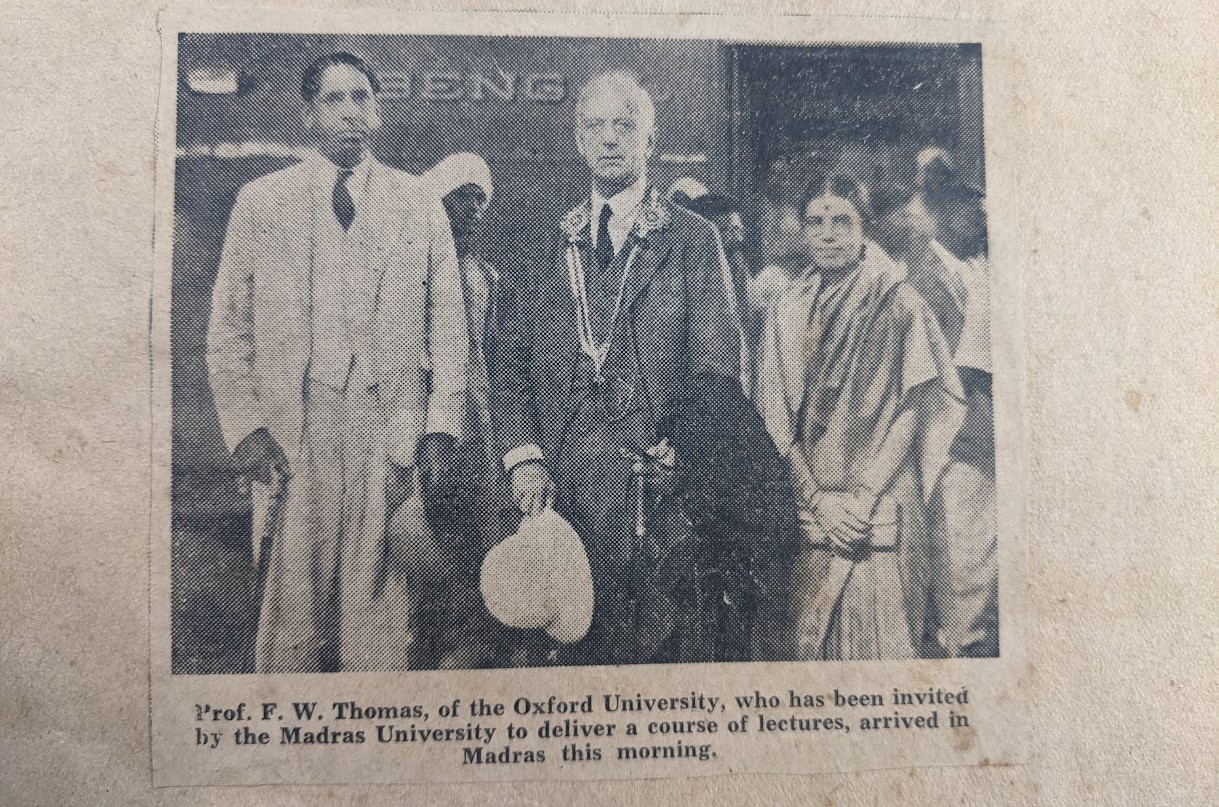
C Minakshi (right) with English Indologist FW Thomas from Oxford University, who had been invited by the University of Madras (Mahalakshmi Gourishankar)
Sometime in the 1930s, a woman clad in saree climbed up a high wall of a temple near Kanchipuram. The temple was old and crumbling. That did not stop her from looking for treasures — historical inscriptions from centuries ago. From one of the cracks, sprang out a cobra, angry and hooded. She had to stop her study abruptly. She jumped down quickly and left the place.
The woman who was risking her life to study inscriptions was C Minakshi, a path-breaking historian and the first woman to receive a PhD from Madras University. Today, September 12, is her birth anniversary.
The 2022 Chess Olympiad put Mamallapuram again on the global map.
The port town was an important power centre of the Pallava empire, which ruled over large parts of South India from around the 4th century to the 9th century.
In the Tamil area, the medieval Cholas took over from the Pallavas and the novel Ponniyin Selvan, which is being adapted into a film now, is set in the second half of the 10th century.
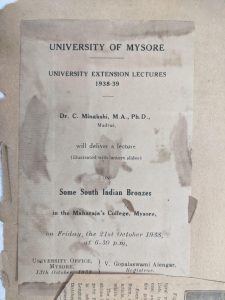
An invitation to a lecture by C Minakshi on ‘Some South Indian Bronzes’ at the Maharaja College, Mysore in 1938 (Mahalakshmi Gourishankar)
We know about the Pallavas, their power, their art, administration, and religion thanks in large part to the work of Minakshi.
Her scholarship was not restricted to the Pallavas. She worked on Buddhism and Jainism in Tamil Nadu and made important discoveries.
She also wrote countless articles in newspapers, reviewed books on history, delivered lectures, and also was a trained musician who performed to an audience sometimes.
She achieved all this in a very short span of time. Minakshi passed away in 1940. She was 34.
Minakshi did her undergraduate studies in the Women’s Christian College, majoring in history and economics. After completing her MA History in the Madras Christian College, she started her PhD research in Madras University in 1936.
She studied under Prof KA Nilakanta Sastri, a pioneer in South Indian history, known especially for his work on the Cholas.
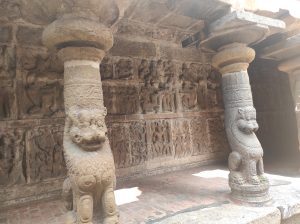
Historical sculptures on the walls of the Vaikunta Perumal temple, Kanchipuram (Prasanna RS/South First)
During this period, Minakshi studied temples in Kanchipuram, the former capital of the Pallavas. Almost every week for many years, she travelled to study sculptures and inscriptions in the city, which was a major centre of learning during the Pallava era. The university provided her just ₹75 as stipend per month.
During her times, there was very little literature on Kanchipuram and the Pallavas. A lot about the empire was a mystery.
One such puzzle was the 100-plus sculpture panels on the walls of an 8th century Vishnu temple in Kanchipuram. Some historians before her believed the sculptures were mythological. She proved them wrong.
She visited the Vaikunta Perumal temple countless times. “A perceptive scholar that she was, Dr Minakshi felt instinctively that they were all petrified chapters of Pallava history,” writes S Swaminathan, a former librarian in the Connemara Library.
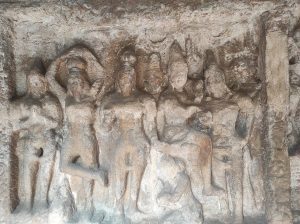
One of the sculpture panels on the walls of the Vaikunta Perumal temple, Kanchipuram (Prasanna RS/South First)
All these sculptures depict the Pallava lineage in a chronological manner. It is rare for a temple to have so many historical sculptures. Every panel was a snapshot of history, a storyboard of sorts, sculpted on stone.
When visiting the Vaikunta Perumal temple in Kanchipuram, do take a look at the book by Minakshi where she has written in detail about each sculpture panel.
Swaminathan was Minakshi’s neighbour who would visit her home every morning and evening and type out her thesis on a typewriter.
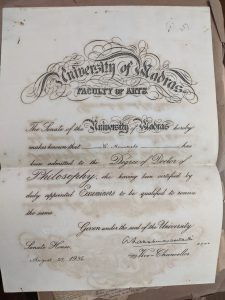
C Minakshi’s doctorate degree. As was the case with the degree certificate of India’s first woman engineer Lalitha, the letter ‘s’ has been written before ‘he’ ‘(Mahalakshmi Gourishankar)
In 1938, for her PhD degree, Minakshi submitted her work on:
1) “The Historical Sculptures of the Vaikunthaperumal Temple, Kanchi”
2) “The Kailasanatha Temple, Kanchi”
3) “Administration and Social Life under the Pallavas”
One of her examiners was KN Diksit. Then the director general of Archaeological Survey of India (ASI), he “remarked that any one of these three theses would have earned for her the coveted degree”.
Not many ancient palaces have been discovered in South India.
Minakshi, with her “unquenchable thirst and enthusiasm … made several vain attempts to excavate the Pallavamedu in Kanchipuram”, a site that is believed to have been a Pallava palace.
She even succeeded in unearthing a few giant bricks, “carried them home triumphantly and consulted a scholar who had just returned from a trip to the Mohenjodaro”. The scholar even remarked that the bricks were more or less similar in size to the ones he had seen in Mohenjodaro. Today, Pallavamedu has been left buried, as does the history that lies underneath.
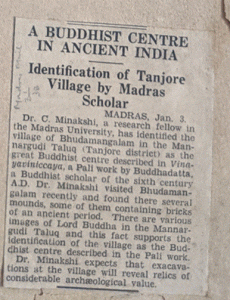
A newspaper article in which C Minakshi says that she expects “excavations at the village will reveal relics of considerable archaeological value” (Mahalakshmi Gourishankar)
Minakshi’s research was not restricted by geography. She discovered a Buddhist center in Thanjavur. She referred to a sixth century Pali text by a Buddhist philosopher and identified various images of Lord Buddha in Bhudamangalam. Below is a newspaper clipping from the past, which ends on a note that she expects “excavations at the village will reveal relics of considerable archaeological value”.
During that time, a few kilometers away from Thanjavur, in a village called Tandandottam, locals found many bronze idols and copper plates while digging for a foundation.
Minakshi studied the idols and also wrote an article in The Quarterly Journal of the Mythic Society. The copper plates belonged to the Pallava era, and she says they were deposited in the Madras Museum. (I am not sure if they are present today in the museum, there is no record of it online.) But the bronze idols, she feels, are early Chola.
Minakshi was also a Carnatic vocalist, and delivered performances to the public.
In one of them, she performed a song composed by the Pallava Emperor Mahendravarman.
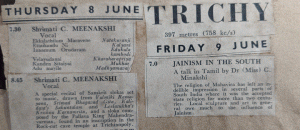
C Minakshi sings a song composed by Mahendravarma Pallava in the early 7th century CE, inscribed on the Tiruchy Rockfort (Mahalakshmi Gourishankar)
The song is from an inscription found in the upper rock-cut temple in the Tiruchy Rockfort that overlooks the Kaveri river. The song begins with a reference to the river: ‘Kaveri Nayana…’
Many people visit the Ganesha temple at the top of the famous Rockfort. But they miss out on the 1,300-plus year-old cave temple and sculptures on the way (and also the lower rock-cut cave temple attributed to the Pandyas to the left of the entrance).
Her knowledge of music also helped her decipher the musical inscriptions in Kudumiyanmalai, which she wrote in one of her theses.
After failing to get a job in All India Radio (because she was a woman), she received an offer for the post of assistant professor from a college in Bangalore.
But soon in 1940, Minakshi passed away due to an unidentified fever. She was working on ‘Buddhism in South India’ for her D. Litt degree. In newspapers, scholars and historians lamented the loss of a scholar unparalleled.
The famous Harikatha exponent C Saraswathi Bai also mourned the loss of Minakshi who was her “most intimate friend for some years”. She also mentions that Minakshi was a “musician of a high order and could sing most beautifully”.
Almost all letters exchanged between the scholar and her colleagues show the esteem she enjoyed in academic circles.
Mirza Muhammad Ismail, the Dewan of Mysore, Gabriel Jouveau-Dubreuil, the famous French archaeologist (and who incidentally was much later found to be involved in the theft of idols from India), and others thank her profusely for sending across her books.
It is perhaps fitting to end this tribute with these words about Minakshi from her professor KA Nilakanta Sastri.
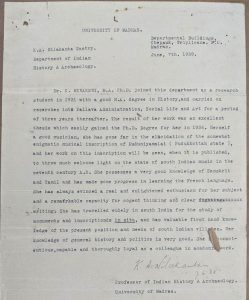 (None of the books of Dr C Minakshi are in print today. Here are the links to some of her works:
(None of the books of Dr C Minakshi are in print today. Here are the links to some of her works:
The Historical Sculptures of the Vaikunthaperumal Temple, Kanchi
Administration and Social Life under the Pallavas)
(My heartfelt thanks to Mrs Mahalakshmi Gourishankar, the daughter-in-law of Prof C Lakshminarayanan who was Dr C Minakshi’s brother. Mrs Mahalakshmi patiently took me through all these clippings and letters, without which this article would not have been possible. My thanks to historian Chitra Madhavan, whose lectures on South Indian history introduced me to C Minakshi)
(Poorani Balendra was a former journalist at The New Indian Express. She now writes on history and works as a marketer in a tech company)

Feb 28, 2024

Feb 18, 2024

Feb 12, 2024

Feb 11, 2024

Feb 06, 2024

Aug 29, 2023